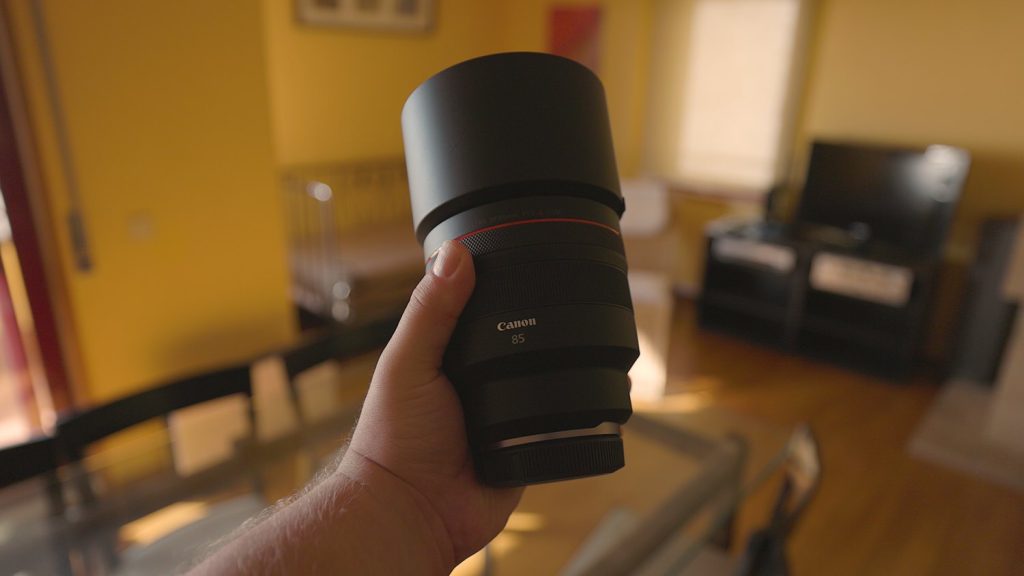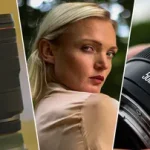Well, hello there. Are you in the market for a new lens and wondering which one to choose? In this review, we will compare two very different but popular options from Canon: the Canon EF 50mm f1.8 and the Canon RF 85mm f1.2 L USM.
By the end of this review, you’ll better understand each lens’s strengths and weaknesses to help you make an informed decision. Let’s dive in and see how these lenses stack up against each other.

Aperture & Focal Length
Let’s begin our lens comparison by closely examining their respective apertures and focal lengths.
First, let’s examine the aperture of each lens.
The Canon RF 85mm f1.2 lens boasts a wider aperture than the Canon EF 50mm f1.8 lens, which is f1.2. It’s worth noting that a smaller f-number indicates a wider aperture, allowing the lens to capture more light.
The RF 85mm f1.2 lens’s larger aperture provides a notable advantage over the f1.8 lens. However, we’ll delve deeper into other features and benefits of these lenses later in the review.
If you’re unfamiliar with the terms EF and RF, don’t worry – we’ll provide more information on what they mean later on as well.
Next up, the remaining figures in the names of the lenses refer to their respective focal lengths, which indicate the lens’ magnification. In this case, one has a focal length of 50mm, and the other is 85mm.
Prime
One of the notable characteristics of a 50mm focal length is that it closely resembles what we see with our own eyes. Since both lenses have a fixed focal length, they are known as prime lenses.
Now, you might be wondering why anyone would choose a prime lens over a zoom lens, which offers greater versatility. The benefit of using a prime lens is that it can produce sharper images due to its fixed focal length.
This can be particularly advantageous for portraits, or low-light photography. Later in this review, we’ll explore other factors that differentiate these two lenses and help determine which one might be a better fit for you.
The choice of focal length can significantly impact the outcome of a photograph, as different focal lengths have varying levels of distortion.
Compared to a lens with a wider focal length, such as a 35mm lens, the 50mm lens has a narrower field of view, which means it will capture less of the scene in the frame, when a photo is taken from the same spot.
Distortion
It’s important to remember that different focal lengths can affect the appearance of the subjects in a photo due to their unique distortion characteristics.
For example, the choice of focal length can significantly impact how a person’s face appears in a photograph. Even if the photographer steps back to balance out the extra zoom of a longer focal length lens, the person’s face may still appear slightly altered when captured with a 50mm lens compared to a 100mm lens, for example.
Generally speaking, an 85mm lens is considered the ideal focal length for portrait photography, as it is believed to create the most flattering representation of the subject’s face. 50mm lenses are often considered a close second due to their similarity in focal length to 85mm. It’s important to note that this is not a hard and fast rule, but rather a guideline to keep in mind.
Ultimately, the choice of which lens to use will depend on the intended subject of the photograph, as well as other factors like the shooting environment, lighting conditions, and personal preferences.

Size & Build
So, how easy are these lenses to carry?
The Canon EF 50mm f1.8 lens measures 69.2 x 39.3mm, or 2.7 x 1.6″, and weighs 160g, or 5.7 oz. Meanwhile, the Canon RF 85mm f1.2 lens measures 117.3 x 103.2mm, or 4.62 x 4.06″, and weighs 1.2kg, or 2.63lb.
Clearly, the RF 85mm lens is the beefiest in this case.
Both lenses are well-constructed, with metal mounts, but the EF 50mm f/1.8 lens has a somewhat plastic feel. The RF 85mm lens is of fantastic quality, as you might expect, given its astronomic price. You can find affiliate links below if you’re interested in finding out the current pricing for these lenses in your area.
Image Quality
Ok, so what can these lenses do? Let’s start by covering their minimum focusing distance.
Minimum Focusing Distance
The lens’s minimum focusing distance refers to the closest distance at which the lens can focus on a subject. This can significantly impact the types of photos you can capture, particularly when it comes to close-up photography.
For instance, if you’re trying to take a close-up picture of a flower, you may find that as you move closer to it, the camera is unable to focus properly. In simpler terms, a lens with a shorter minimum focusing distance will allow you to get closer to the subject, capturing more intricate details in the process.
In general, a shorter minimum focusing distance can provide greater flexibility and creativity in your photography, as you have the ability to get up close and personal with your subjects. However, this also depends on the type of photography you are interested in.
It’s essential to consider these factors when choosing a lens that suits your needs. The EF 50mm f1.8’s minimum focusing distance is 35cm, or 13.78″, while the RF 85mm f1.2 needs at least 85cm or 2.79ft.

Sharpness
Ok, so how sharp are these lenses?
The Canon RF 85mm f1.2 is way sharper, when comparing these two. When it comes to more affordable lenses, you may find that sharpness is not consistent across the entire frame when you zoom in. Typically, lenses tend to be sharper in the centre than on the edges.
While sharpness is certainly an important consideration when choosing a lens, it’s not the only factor to keep in mind. Other factors, such as bokeh, focal length, and versatility, can significantly impact the lens’s overall usefulness.
Vignetting
Right, what about vignetting?
The Canon RF 85mm lens can produce a little vignetting, while the Canon EF 50mm f1.8 lens produces more; however, this issue can easily be fixed in postproduction.
Also, I personally quite like some vignetting in my photos, as I find that it tends to give them more depth.
Chromatic Aberration
What about chromatic aberration?
Again, the Canon EF 50mm lens exhibits more, while the Canon RF 85mm f1.2 lens shows very little, but this is not a significant issue. The chromatic aberration is usually visible when the photos are taken in low light, particularly during sunset. It appears as colour bleeding along straight edges in the images.
Although it is not noticeable to most people, knowing that both lenses can exhibit chromatic aberration is essential. Practically, any lens can have this issue, but more affordable lenses tend to display it more.
Image Stabilisation
Does either of these lenses have IS (image stabilisation)?
No, neither of these lenses has image stabilisation. Based on its price, you might think the Canon RF 85mm f1.2 lens has it, but that is not the case.
Autofocus
Ok, what about autofocus?
The Canon EF 50mm lens, which is more affordable, has an STM motor, while the Canon RF 85mm lens is equipped with a USM motor.
The STM motor is commonly found in entry-level lenses and is recognised for its smooth, accurate, and quiet operation when shooting video.
In contrast, the USM motor is typically found in higher-end lenses and is known for its speedy, accurate, and noiseless operation.
While both motors are excellent options, the USM is generally considered better for fast action and sports photography. At the same time, the STM is a great choice for capturing video and other quiet scenes.
Compatibility
Right, so what cameras can I mount these two lenses on?
The Canon RF 85mm f1.2 L USM lens is specially created for Canon’s RF mount cameras, including the Canon R, R5, and R6. On the other hand, the Canon EF 50mm f1.8 lens has a different mount system designed to be used with Canon’s EF and EF/EF-S cameras, which are more commonly found in budget-friendly options.
However, it is possible to mount the Canon EF 50mm lens onto an RF body, such as the Canon R5, with the use of an adapter.

Vlogging
Right, so what about vlogging?
Neither the EF 50mm f1.8 lens nor the RF 85mm f1.2 lens is ideal for vlogging, despite the RF lens’s price point. Both lenses have limitations that make them less than optimal for this application.
Firstly, neither lens has built-in image stabilisation (IS), which can result in shaky footage. Although mounting either of these lenses on a camera with in-body image stabilisation (IBIS), such as the Canon R5, can help mitigate the lack of built-in IS, there is another issue to consider.
Both lenses have a relatively narrow field of view. This means that even when using a Gorillapod, the 50mm focal length may be too zoomed in for handheld vlogging.
Here’s vlogging footage with the EF 50mm f/1.8 on a Canon 77D. The image is far too zoomed in, even at 50mm, especially on a cropped-sensor body.
YouTubers
If your goal is to create content from home with the camera mounted on a tripod, the absence of image stabilisation (IS) won’t be an issue for either the Canon EF 50mm f1.8 or the Canon RF 85mm f1.2 lenses. Since the camera will be fixed in one place, there will be no camera movement to cause shake or instability in the footage.
Therefore, you can expect to get excellent results from both lenses when used in a controlled environment, such as when recording content from home with the camera mounted on a tripod.
I’d recommend the RF 85mm lens specifically, as the fact that it can open up to f1.2 means that you can film in more low light conditions, and it also ensures you’ll get even nicer Bokeh.

Applications
Ok, so what are these lenses designed for?
Portrait Photography
What if you want to do portraits? Both the EF 50mm f1.8 lens and the RF 85mm f1.2 lens are suitable for portrait photography. However, the RF lens has a slight edge in this category.
The 85mm lens has a slightly wider aperture, allowing in more light and enabling shooting in a broader range of environments. Additionally, it produces more luxurious Bokeh, which can help to emphasise the subject’s facial features and make them stand out from the background.
Street Photography
Regarding street photography, either lens can be used for this purpose, but caution should be exercised, particularly if you have an expensive camera setup.
Pro-looking gear, like either of these lenses, can sometimes attract unwanted attention from onlookers. Therefore, it’s important to remain aware of your surroundings and take steps to protect your equipment while taking photos on the street.
Product Photography
Ok, what if I want to photograph products? Both the Canon EF 50mm f1.8 and the Canon RF 85mm f\1.2 lenses are suitable for product photography, and their effectiveness depends on the camera you use with them.
Landscape Photography
Regarding landscape photography, both lenses would perform well, and there is no significant difference between them, except for the fact that the RF 85mm lens would produce sharper images overall.
Fashion Photography
For fashion photography, I’d actually recommend the RF 85mm lens, as it is perfect for portraits. The 85mm focal length is considered ideal for portraits, and the fact that the lens opens up to f/1.2 is also a great added bonus.
Documentary Work
What about documentary-style shooting? The EF 50mm f1.8 and the RF 85mm f1.2 lenses can both be used for documentary-style work. However, the RF 85mm lens has a slight advantage in this category as its wider aperture lets in more light, making it slightly more versatile.
Sports or Wildlife
Regarding capturing sports or wildlife, neither the EF 50mm f1.8 nor the RF 85mm f1.2 lens is ideal. They cannot zoom in close enough to capture fast-moving action or subjects that are far away. For these types of photography, it’s best to use a telephoto lens with a long focal length to capture the details from a distance.
Wedding and Event Photography
For event or wedding photography, either lens can be utilised. Given that you’ll mostly be doing portraits, and detail shots, both lenses would work very well. However, the 85mm lens would still give you that extra edge with portraits.

Control
Ok, so how easy are they to use?
Both the EF 50mm f1.8 and the RF 85mm f1.2 lenses offer a pleasant shooting experience and are of decent quality.
They both have smooth manual focus rings that allow you to make precise adjustments to the focus. Obviously, the RF 85mm f1.2 is way nicer in basically every way, but it is also way, way more expensive.
The RF 85mm lens also has a customisable control ring, allowing you to assign various functions to it, such as changing ISO.
Some people, including myself, choose to just keep it disabled, as I don’t like the idea of accidentally changing settings during a shoot. However, this function might serve you well.
Longevity
Right, so how long can I expect them to last? Both lenses have metal mounts, which is great for longevity, but while the RF 85mm lens is protected from dust and splashes, the EF 50mm lens has no weather sealing.
Filters
Many photographers, myself included, prefer to use a UV filter as an extra layer of protection for the lens element. I use Sigma ceramic UV filters that stay on my lenses all the time, having been added right after I bought the lenses.
Although Sigma ceramic UV filters can be expensive, the added protection is worth it, particularly for more expensive lenses.
Attaching a filter to the lens also eliminates the need for lens caps, although they can still be used if desired.
When purchasing filters for these lenses, it’s crucial to consider their filter size, which differs from their focal lengths.
The EF 50mm lens has a filter size of 49mm, while the RF 85mm lens has a filter size of 82mm. It’s important to remember this as many people initially mistake filter size for focal length.

Recommendations
I hope this has been helpful. I invite you to have a look at some of my other articles. We have something for everyone, whether you’re interested in audio, or cameras and lenses. Alternatively, if you prefer video reviews, feel free to have a look at my YouTube channel.
Finally, down below you will find all of the items I talked about in this article.



